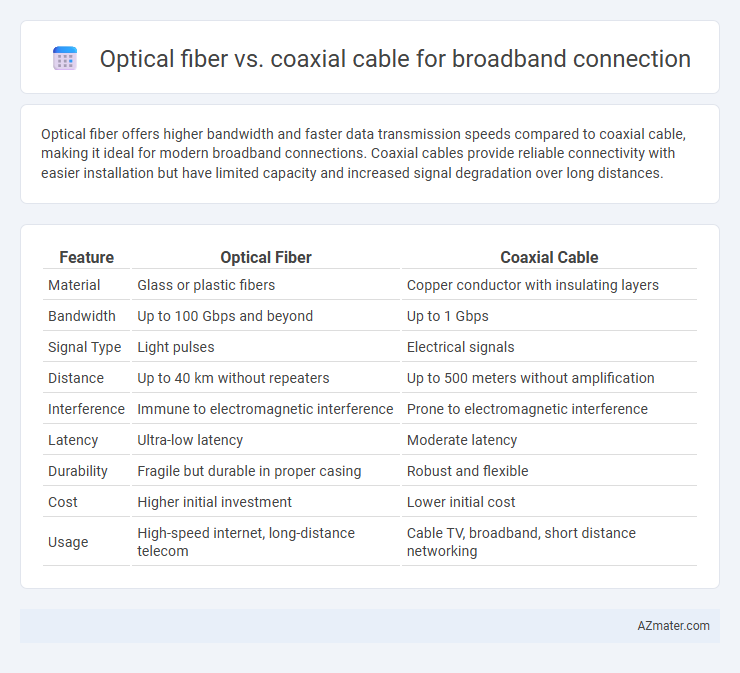Optical fiber offers higher bandwidth and faster data transmission speeds compared to coaxial cable, making it ideal for modern broadband connections. Coaxial cables provide reliable connectivity with easier installation but have limited capacity and increased signal degradation over long distances.
Table of Comparison
| Feature | Optical Fiber | Coaxial Cable |
|---|---|---|
| Material | Glass or plastic fibers | Copper conductor with insulating layers |
| Bandwidth | Up to 100 Gbps and beyond | Up to 1 Gbps |
| Signal Type | Light pulses | Electrical signals |
| Distance | Up to 40 km without repeaters | Up to 500 meters without amplification |
| Interference | Immune to electromagnetic interference | Prone to electromagnetic interference |
| Latency | Ultra-low latency | Moderate latency |
| Durability | Fragile but durable in proper casing | Robust and flexible |
| Cost | Higher initial investment | Lower initial cost |
| Usage | High-speed internet, long-distance telecom | Cable TV, broadband, short distance networking |
Introduction to Optical Fiber and Coaxial Cable
Optical fiber uses thin strands of glass or plastic to transmit data as light signals, offering high bandwidth and low signal attenuation for broadband connections. Coaxial cable consists of a central copper conductor surrounded by insulating layers and a metallic shield, enabling moderate bandwidth and better resistance to electromagnetic interference compared to traditional copper lines. Optical fiber supports faster internet speeds and longer distances without signal degradation, while coaxial cable remains widely used for cable TV and broadband due to its durability and cost-effectiveness.
How Optical Fiber Works
Optical fiber transmits data using light signals through thin strands of glass or plastic fibers, enabling extremely high-speed broadband connections with minimal signal loss over long distances. Data is encoded onto light pulses generated by lasers or LEDs, which travel through the fiber core via total internal reflection, ensuring efficient transmission. This technology outperforms coaxial cable by providing greater bandwidth capacity, immunity to electromagnetic interference, and faster data transfer rates essential for modern high-speed internet.
How Coaxial Cable Functions
Coaxial cable functions by transmitting broadband signals through a central copper conductor surrounded by insulating material, a metallic shield, and an outer plastic jacket, which reduces electromagnetic interference and signal loss. It carries data using radio frequency (RF) signals, making it suitable for cable television and internet services. Compared to optical fiber, coaxial cable offers moderate bandwidth and distance capabilities but is more susceptible to signal degradation over long runs.
Speed and Bandwidth Comparison
Optical fiber offers significantly higher speed and bandwidth compared to coaxial cable, supporting data transmission rates exceeding 1 Gbps to multiple terabits per second in advanced networks. The fiber's ability to transmit light signals with minimal attenuation and interference enables consistent high-speed broadband connections over longer distances than coaxial cables, which typically max out at around 1 Gbps under optimal conditions. Fiber optic technology also provides greater bandwidth capacity, facilitating simultaneous data-heavy applications such as streaming, gaming, and large file transfers without degradation in performance.
Reliability and Signal Quality
Optical fiber provides superior reliability and signal quality compared to coaxial cable due to its immunity to electromagnetic interference and lower signal attenuation over long distances. Fiber optic cables offer consistent high-speed broadband performance with minimal latency and virtually no signal degradation. In contrast, coaxial cables are more susceptible to signal loss and interference, resulting in lower overall reliability and degraded signal quality in high-demand broadband environments.
Installation and Maintenance Differences
Optical fiber installation requires precise handling and specialized equipment to splice delicate glass fibers, often demanding professional expertise and higher initial costs compared to coaxial cable. Coaxial cable installation is generally simpler, using standard connectors and tools, allowing for quicker deployment and easier troubleshooting. Maintenance of optical fiber involves checking for signal attenuation and repairing microscopic breaks, while coaxial cable maintenance typically focuses on addressing physical damage and connector wear, influencing long-term reliability and service quality.
Cost Analysis: Optical Fiber vs Coaxial Cable
Optical fiber offers higher bandwidth and faster internet speeds but involves a higher initial installation cost compared to coaxial cable, which is more affordable for short-distance deployments. Maintenance costs for optical fiber are generally lower due to its resistance to electromagnetic interference and durability, whereas coaxial cables may incur more frequent repairs in harsh environments. Long-term cost efficiency favors optical fiber as its capacity and future-proofing reduce the need for costly upgrades.
Scalability and Future-Proofing
Optical fiber offers superior scalability compared to coaxial cable due to its exponentially higher bandwidth capacity and ability to handle increased data traffic without significant signal degradation. Future-proofing is enhanced with fiber optics as it supports evolving broadband technologies and higher speeds, ensuring long-term infrastructure viability. Coaxial cable, while cost-effective initially, faces limitations in speed upgrades and distance, making it less adaptable for future broadband demands.
Security Considerations
Optical fiber offers superior security for broadband connections due to its resistance to electromagnetic interference and difficulty in signal tapping compared to coaxial cable. The intrinsic nature of fiber optic signals, which transmit light rather than electrical signals, significantly reduces the risk of data breaches and unauthorized access. Coaxial cable, while more susceptible to signal interception and interference, remains a viable choice where security demands are lower or cost constraints exist.
Which is Better for Broadband?
Optical fiber offers significantly higher bandwidth and faster internet speeds compared to coaxial cable, making it ideal for high-demand broadband connections. Its lower signal attenuation and immunity to electromagnetic interference ensure more reliable and consistent performance over longer distances. While coaxial cable is generally more affordable and widely available, optical fiber is better suited for future-proof broadband infrastructure due to its superior data capacity and scalability.

Infographic: Optical fiber vs Coaxial cable for Broadband connection
 azmater.com
azmater.com